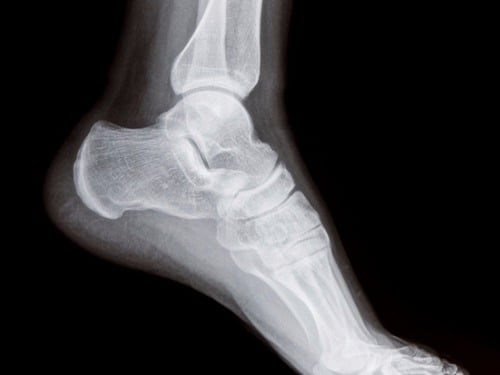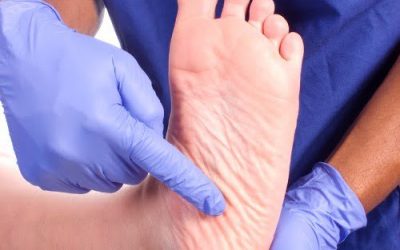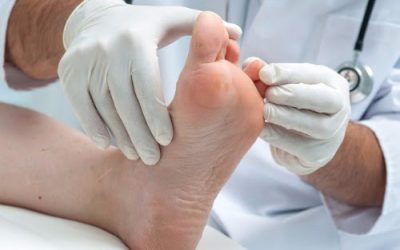Those affected by Charcot-Marie-Tooth disease often display distinct physical symptoms that manifest in their feet. A basic overview of CMT foot symptoms that can be found below.
High Arches and Clawfoot:
The classic, very high arch is formed because the peroneal group no longer properly opposes the tibial muscles. Muscles need to be balanced. The tibial muscles get “free reign” and work without an opposing balance. This results in a pulled up arch, tipping the foot outwards, which creates instability, tiredness, and can lead to ankle sprains.
Motor weakness is the hallmark of CMT and is the cause for clawfeet. The ankle dorsiflexors, the muscles that lift up the foot and ankle, are frequently involved. When the Tibialis Anterior muscle weakens, the foot begins to drop down. This is usually a gradual process, occurring over months or years.
Treatment for Clawfoot
It is very important to keep the Achilles tendon in the calf stretched out. Keeping the Achilles limber can keep a person walking normally for a long time. Stretch the tendon for 60 seconds 3 times each day. There are several stretching programs available, but the easiest and best is to place the front of the foot on a step and let the heel hang over the edge (hold on to the railing to keep your balance).
In more advanced cases, a brace may be required. There are several types available, which are generically called Ankle Foot Orthoses (AFOs). An Orthotist or certified Pedorthist are the professionals who fabricate such braces.
Deformity of the Toes
Deformity of the toes occurs frequently in people that have CMT. An imbalance of muscle pull on the toes causes them to deform. The term “clawing” is used because each toe develops a fixed flexion contracture in the shape of a claw. The contracted toes do not have enough room in shoes and put increased pressure on the ball of the foot, which becomes painful and callused.
Treatment for Deformity of the Toes
While there is nothing one can do to prevent the muscle imbalance, the contractures can be avoided, or at least delayed. Twice a day, once in the morning and once before bedtime, stretch each of the toe joints. Flex down the joint at the base of each toe (Metatarsalphalangeal joint) as far as possible while bringing the middle joint (Proximal Interphalangeal joint) to a straight position. Hold for thirty seconds and then go onto the next toe.
Once a contracture develops, make sure to wear shoes that have a wide toe box to minimize pressure on the toes. A shoe repair shop can stretch out your normal shoes or special wide toe-box shoes can be purchased. Your shoes should have a cushioned sole and be made of a soft, stretchable upper material. A custom orthotic can help relieve pressure on the ball of the foot.
Ingrown Toenails
The toenail is produced by its own special nail-generating tissue and grows forward to the end of the toe. In the case of the ingrown toenail, which tends to occur most often with the big toe, the nail groove begins to disappear. This can be the result of ill-fitting shoes, or from a deformed way of walking that places an unusual amount of pressure on this area of the foot.
The chronic pressure of the nail edge rubbing against the nail groove causes irritation and swelling of the surrounding skin. This constant pressure can eventually results with infection, leading to even more pain and swelling. Improper trimming of the toenail can also cause problems. If the corner of the toenail is not allowed to grow out past the skin at the end of the nail groove, it may dig into the skin. This makes pressure when walking even more painful.
Ingrown toenails are a common problem for people with CMT due to the pressure placed on the front and side of the foot while walking. When hand dexterity difficulties are an issue, this further exacerbates the problem as nail and foot care can be a challenging task to perform.
Treatment for Ingrown Toenails
Due to sensory loss association with CMT, especially in the foot, it is an important practice to take extra precautions with foot care. If necessary, seek professional assistance to ensure your toenails are regularly trimmed and monitored for ingrown toenails and other problems.
There are various surgical procedures to assist if the condition has been longstanding and resulted in permanent hypertrophy of the tissue surrounding the nail margin. A wedge resection procedure removes of a portion of the hypertrophied tissue and therefore reduces the pressure and irritation. In this procedure, a wedge of tissue is removed and the healing process allows the nail groove to reform itself a partial nail and matrix removal is done in more severe cases; this removes a portion of the toenail and the germinal matrix that produces that portion of the nail. For extreme deformity, a nail and matrix ablation is done to remove the entire nail and its germinal matrix. No new toenail will grow back and this is usually done only as last resort.
Fungal Toenails
According to Dr. Hal Ornstein on footdoctorsnj.com, many people do not realize they have a fungal nail problem and, therefore, do not seek treatment. Yet, fungal toenail infections are a common foot health problem and can persist for years without ever causing pain. The disease, characterized by a change in a toenail’s color, is often considered nothing more than a mere blemish. Left untreated, however, it can present serious problems.
You can prevent fungal nail infections by taking these simple precautions:
- Exercise proper hygiene and regularly inspect your feet and toes.
- Keep your feet clean and dry.
- Wear shower shoes in public facilities whenever possible.
- Clip nails straight across so that the nail does not extend beyond the tip of the toe.
- Use a quality foot powder (talcum, not cornstarch) in conjunction with shoes that fit well and are made of materials that breathe.
- Avoid wearing excessively tight hosiery, which promotes moisture. Socks made of synthetic fiber tend to “wick” away moisture faster than cotton or wool socks, especially for those with lifestyles that are more active.
- Disinfect home pedicure tools and don’t apply polish to nails suspected of infection.
- In severe cases, surgical treatment may be required to remove the infected nail. Permanent removal of a chronically painful nail, which has not responded to any other treatment, permits the fungal infection to be cured and prevents the return of a deformed nail.
Swollen Feet and Ankles
Dr. Greg Carter, one of our CMT advisors, says:
“People with CMT have swelling in their feet and ankles because they don’t have the normal muscle strength and activity in the legs that helps pump the venous blood and lymphatic fluids back towards the heart. This is common in many neuromuscular disorders. Breathing and/or heart problems can definitely cause swelling of the feet and ankles, and can be an early sign of heart failure. People with CMT have to be particularly careful because swollen feet and legs can lead to skin breakdown and ulcers. These ulcers may get infected and sometimes lead to loss of the foot or leg (i.e., if they get gangrene). CMT people are already prone to neuropathic ulcers so they are at very high risk.”
Treatment for Swollen Feet and Ankles
Dr. Carter suggests CMT patients should treat their feet just like diabetics do: daily inspection; gentle soak and cleansing; emollient creams to keep the skin supple; proper foot- wear and correctly fitted braces/orthotics (CMT people should always use custom-fitted braces/orthotics, not off-the-shelf models). TED hose are okay as long as they are taken off for part of the day and the skin thoroughly inspected. Further, CMT people should not smoke because this can lead to peripheral vascular disease (hardening/clogging of the arteries), which worsens the situation.
Calluses
Heel calluses, also called plantar calluses, develop when one metatarsal bone is longer or lower than the others and it hits the ground with more force than it is equipped to handle. As a result, the skin under this bone thickens. The resulting callus causes irritation and pain.
Treatment for Calluses
Because people with CMT often have an imbalanced gait, calluses easily can form. In most cases, heel calluses can be treated without surgery. In severe cases, however, a surgical procedure called an osteotomy is performed to relieve the pressure on the bone.
Restless Leg Syndrome
Restless Leg Syndrome is a sensory-motor disorder and is evidentially related to periodic limb movement disorder (PLMD). Similar to CMT there is often a family history of RLS. People describe the sensation in their legs in a variety of ways such as, tingling, pins and needles, creepy-crawling sensations, sudden jerky movements, and having an irresistible urge to move their legs. Movement temporarily helps to relief the discomfort. RLS becomes more apparent when individuals are at rest and can be very disruptive to the onset of sleep, which ultimately lessens the restfulness that we require from sleeping. It can be disturbing for partners of people who experience RLS as well.
Treatment for Restless Leg Syndrome
There are OTC and prescription medication for the treatment of symptoms. Some lifestyle changes also may alleviate symptoms.







I have had CMT my whole life but not diagnosed till in my early 50’s.
I have had Breast cancer 2x and after radiation had a turn for the worse with my right foot turning outward so I walk on outside edge of foot. This
is very painful for my ankle and hard to walk. I am trying to get used to an AFO but it is not easy. I have pain in different areas due to rubbing or pressure spots. I often wondered if radiation had anything to do with my foot turning outward as it happened after my second course of it. Has anyone else had this issue with their CMT?
Another thing I have noticed is that I swim for exercise since I can’t walk distance. I noticed my muscles really hurt in my arms and legs when I am not swimming. I might not go a couple of times I am supposed to and this is when the soreness occurs.
I have CMT with lower extremity edema that is progressive any treatment suggestions
I am 62 and having terrible trouble with my left leg turning out onto the outside of the length of the foot when I walk. It is giving me severe problems with twisting my knee and and I have tried so many different braces, insoles etc and no one seems to hit the nail on the head to crack this. I wonder if there is anyone anywhere that could help fix it
J-
I am having the same problem walking on outside edge of foot. Really painful for the ankle. I am trying to wear an AFO but it too is painful. I thought all the radiation I had caused this but now see others are experiencing the same without radiation.
I do not have any answers sorry but if I ever do I will let you know
I was diagnosed with Cerebral Palsy as a toddler due to having heel cord tightness, being a toe walker, and having an odd gait. At 9 I was diagnosed as having CMT due to having a nerve conductor test. So I have both…
I walk a bit weird, as I almost use the ball of my foot and toes to pull my feet forward.
Both of my feet are callused at the ball and heel of the foot. Particularly thick on the large toes and at the center of the balls of my feet. I am curious to know if this normal due to how I walk or if I should be checked out
Does anyone else here have a constant pain in their toes? I’ve known that I had CMT since I was a child, I’m 37 now and my symptoms have started getting worse lately
Yes I have toe pain (especially) My big toes. I Was diagnosed with CMT when I was 39. I’ve just started having toe and foot pain in the last six months. The pain in my left toe has become enough to wake me at night.
I know for a portion of my life I had CMT but I recently found out I have CMT1A. I’ve been having a horrible time. I don’t take medication and I don’t have health insurance but lately it’s been a constant feeing of bugs crawling all over. This is the worst it’s been, I’m only 20
Wow can I relate to this sensation of bugs crawling on the surface of the right calf. I went to the ER at the University of Michigan and in comes the team of neurologists. I told them I had the sensation of worms crawling on my right calf. The lead Dr asked me if I was on drugs! Of course not I wasn’t. Then a while later I get this bee sting sensation on my peronius muscle on both calfs,
there have always been new surprises with having CMT .
My dad had CMT and i believe I have MANY of the symptoms. I am trying to get a diagnosis. I have not been able to find a good neuromuscular doctor. I live in the Lancaster PA area. Any suggestions?
I googled CMT Specilists and found mine was the U of M.
can someone recommend a great CMT specialist on Long Island NY?
Hi Lisa,
Please email [email protected] with information on what type of specialist you are looking for. Surgery, Podiatrist, PT, Neurologist…?
Sad, sad day for me, doctor that help treat me with CMT passed away last month. Just found out the day before yesterday and he was a wonderful man. He was my doctor for 20+ years, I’m now 33 and he had help thousands of patients throughout the years at Rush Hospital. He’s the definition of a real one, always seemed to care and I’m glad to have known him, may he rest in peace and may God bless him.
God bless him..may he rest in peace. Sounds like a wonderful man.
I was diagnosed with CMT 10 years ago. Last night was the first time I ever experienced pain. It was a burning sensation in top of big toe. About once every 15 seconds. Is this common? Suggestions to alleviate pain so I can sleep? Thanks.
Hi David,
Similarly, I was diagnosed with CMT 7 years ago. I had minimal symptoms but the last few nights I’ve been experiencing burning sensation in my feet. Do they come and go? Do you do anything that helps?
Hello,
Yes, this is a normal symptom for CMT. I am 57 and have been diagnosed with CMT in my 20s. I have experienced the same pain and other pain in my feet throughout the years as I’ve gotten older it’s gotten a little worse. The only thing I can fine to help for temporary relief is frankincense and myrrh oil that I rub on. It will give me temporary relief so I can sleep, but doesn’t last the doctor has recently put me on gabapentin. Just started it and we’ll see how well it works. I know it’s just a blocker for pain and doesn’t cure anything, but the pain is very bad at times so I’m gonna give it a try.
Have you been to see a neurologist they can help treat the pain. I pray for Saul that they find a treatment soon!!!🙏🏻🙏🏻🙏🏻
I have been diagnosed with CMT but how do i know what type it is? I realized i have had symptoms pretty much my whole life but was only diagnosed 3 yrs ago at the age of 33
The only way to find out is to do extensive blood work but since there are so many variations, like me you may never find out.
1. I wonder about shoes that work for CMT people. I have CMT Type 2 and have struggled to find shoes my whole life!!! I can recommend Merrill’s because they have wide toe box and offer shoes that are light weight, flexible with good non slip grips. I have found shoes can make or break my ability to walk. I am struggling to find a good walking and dancing shoe.
2. My feet are extremely cold most of time. I am 66 and have had CMT for probably 40 years. I have found taking a hot bath right before bed warms up my cold feet and legs and helps me fall asleep. However I need recommendations for warm socks. Has anyone found electric socks battery operated work??? The chemical activated foot inserts are one time use only so they are way to expensive for everyday use.
Oh please, me too!
I hope someone will reply. I am 59 with the same problems with shoes and with chilly feet.
Try SAS shoes
I have cmt but it really hasn’t gotten worse it just stayed the same I am now 23 years old is it possible for my feet to stay the same way, also I never really have pain I play sports and can run, walk and run a little weird but I can do all those stuff and it doesn’t hurt at all. I believe God cured me. But my question still stands lol
To David lenis, I was your age when I realized I was having problems and few years later diagnosed with CMT. I am 41 yrs old now and although I can’t run , play sports, and have a harder time walking I am still very active. I credit the majority of my muscle loss in calves legs to the use of AFOs although they are needed in time for most of us I do wish I would have waited as long as possible to begin using them as they cause you to quit using the smaller muscles during activity and once you loose muscle it doesn’t come back. I hunt mushrooms, fish, hike best I can, and although I might have a hard time doing these activities I push through it, you cannot give in to CMT. I have pain and take no meds for it. I have had blisters like everyone else and just kept on going now my feet are tough as nails and no longer blister. I cannot stress enough how important it is to be active and to have a fighter attitude with this disease. On FB there are groups of fellow CMT patients and they are filled with complaining, giving up, moaning, crying, and people not fighting. Just like muscle loss once you loose the ability to do something it don’t go back so trust me when I say don’t give in to it and end up taking a shit ton of meds for everything under the sun. Push through and keep doing things that you want, believe it or not but a lot of times we are able to find the easy way to do something whereas most able body people do it the hard way. If you can run even if it is hard or looks funny keep doing it even if people stare cause I promise you it will keep you going and you have my word that if I saw you running funny or whatever you would be a inspiration to me and there better not be a single sole staring at you unless it is in amazement of your dedication to living life the best you can. Be strong bro!